
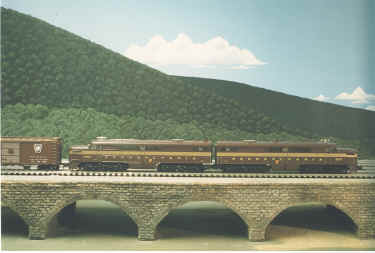
Those who want to read more about this layout are referred to the January 1985 issue of the TCA Quarterly. However, with the paltry selection of realistic O gauge equipment available at that time, the layout was dismantled, and I switched to the far more realistic HO.
The two subsequent HO layouts also portrayed the South Penn. The second
existed between 1987 and 1996, and was featured in the April 1990 and May 1997
issues of Model Railroader. 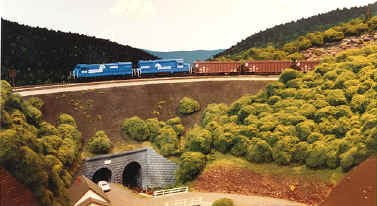 All
the while, I continued to maintain my interest in O gauge. It was during this
time that a gradual shift occurred in the O gauge world...a shift from toy like
trains to detailed scale models that could run on three rail O gauge track.
Fortunately, I continued to collect O gauge trains (though I did not operate
them), primarily in Pennsylvania Railroad livery. However, it was not until a
visit to Herb Lindsay’s beautiful hi-rail layout (see Classic Toy Trains,
April 1990) in 1993 that I became convinced that I could build a credible model
of a railroad using 3 rail O gauge trains.
All
the while, I continued to maintain my interest in O gauge. It was during this
time that a gradual shift occurred in the O gauge world...a shift from toy like
trains to detailed scale models that could run on three rail O gauge track.
Fortunately, I continued to collect O gauge trains (though I did not operate
them), primarily in Pennsylvania Railroad livery. However, it was not until a
visit to Herb Lindsay’s beautiful hi-rail layout (see Classic Toy Trains,
April 1990) in 1993 that I became convinced that I could build a credible model
of a railroad using 3 rail O gauge trains.
With memories of Herb’s layout in mind, as well as the design and
construction of a new home beginning in 1996, I designed a train room uniquely
suited to the construction of a large model railroad. The room included among
other things, a high ceiling, extra electrical circuits, and most importantly, a
“stair pit” which allowed me to actually walk under the around the wall
layout without ducking or bending. 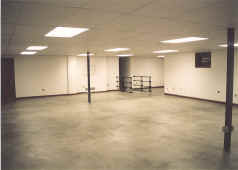 More
importantly, I designed the layout along with the house. For example, the two
columns needed to support the first floor were located so as to be concealed in
the backdrop. The breakfast nook was widened by two feet to allow curved
trackage of 60 inch radius. The final design of the layout is shown here, along
with additional views of the stairpit.
More
importantly, I designed the layout along with the house. For example, the two
columns needed to support the first floor were located so as to be concealed in
the backdrop. The breakfast nook was widened by two feet to allow curved
trackage of 60 inch radius. The final design of the layout is shown here, along
with additional views of the stairpit.
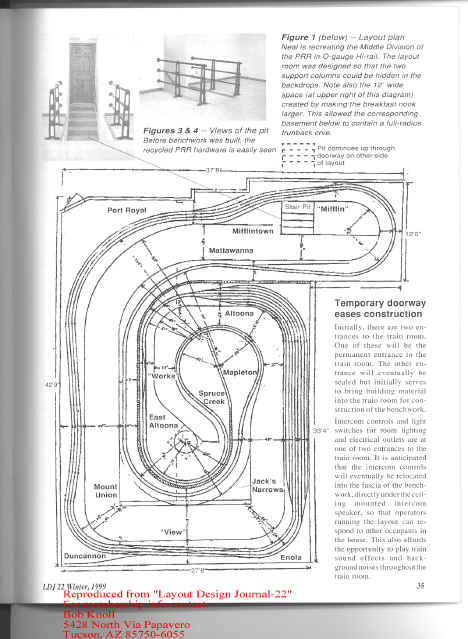
The second Model Railroader article about my HO layout was titled “The Lessons of the South Penn” and laid out some of the principles that I planned on applying to the new O gauge layout. By far, the most important of these was the concept of scenic complexity coupled with operational simplicity. I felt this would maximize my enjoyment of the hobby. The new layout was clearly designed with this in mind. The layout itself measures roughly 45 by 28 feet, and is a total of about 1400 sq. feet. Minimum radius for the most part is 60 inches, though in a few places, it drops as low as 54 inches. The layout is built relatively high...the railhead is 52 inches above the floor...and since I am modeling a water level route, there are no grades to help realize my goal of simple operation. There will be however a lower level (not shown in the drawing of the layout) strictly for storage of assembled trains. At the present time, the mainline between Enola and Port Royal is in service by means of two temporary reversing loops. Scenery consists only of the backdrop and the PRR stone arch bridge at Shermans’s Creek near Duncannon Pa. Painting of the backdrop is one of my favorite aspects of model railroading, and I’ve invested quite a bit of time into it so far. The bridge itself is molded out of hydrocal, and is a full scale model of the real bridge. It is six feet long and weighs 150 pounds!
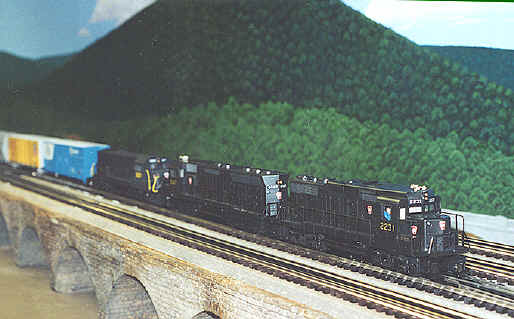
An additional view of the layout shows a Weaver PRR H-10 Consolidation at the town of Duncannon itself. Work is currently underway on the section of the mainline between Port Royal and Mattawanna, and I hope to have this trackage in operation by late fall. The prominent feature of this area is a curved 3 arch stone bridge at Port Royal. Subsequent plans call for installation of portions of the signal system and the construction of three dimensional scenery in the area of View Interlocking near the Sherman’s Creek Bridge. Stay tuned for the latest developments!
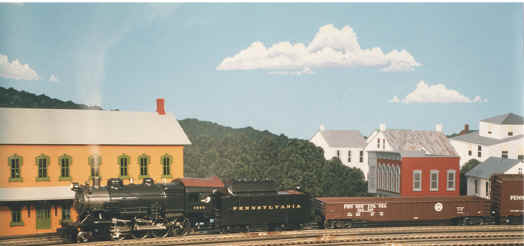
Neal A. Schorr